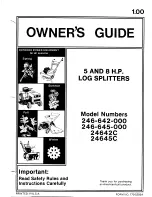
13
Operation
Warning!
Before operating the log splitter, the Bleed
Screw (13) Fig. 16, should be loosened by
some rotations until air can go in and out
of the oil tank smoothly.
Air flow thru the Bleed Screw hole should
be detectable while the log splitter is under
operations.
Before moving the log splitter, make sure
the Bleed Screw is tightened to avoid oil
leaking from this point.
FAILED TO LOOSEN THE BLEED SCREW
WILL KEEP THE SEALED AIR IN
HYDRAULIC SYSTEM BEING
COMPRESSED AFTER BEING
DECOMPRESSED. SUCH CONTINUOUS
AIR COMPRESSION AND
DECOMPRESSION WILL BLOW OUT THE
SEALS OF THE HYDRAULIC SYSTEM AND
CAUSE PERMANENT DAMAGE TO THE
LOG SPLITTER.
Fig. 16
DO NOT ADJUST THE MAX PRESSURE
LITITING SCREW (14) IN FIG. 17!
Max pressure was set before the log
splitter ex work and the max pressure
limiting screw is tightened to ensure the
log splitter works under pressure no more
than 4 tons. The setting was done by
qualified mechanic with professional
instruments.
Unauthorized resetting will cause the
hydraulic pump fail to output enough
splitting pressure or RESULT IN SERIOUS
INJURY AS WELL AS DAMAGE TO THE
MACHINE.
The max pressure limiting screw is
protected by a plastic cap (15) as shown in
Fig. 17, and never to loose and adjust it.
Fig. 17
This log splitter is equipped with “ZHB” control
system that requires to be operated by both
hands of the user – left hand controls the
hydraulic control lever while right hand
controls the pushbutton switch as shown in Fig.
18. The log splitter will freeze upon absence of
either hand. Only after both hands release the
controls, the log pusher starts to return
backward to the starting position.
Never force the log splitter for more than 5
seconds by keeping pressure on it to split
excessively hard wood.

































